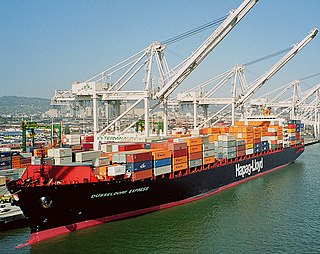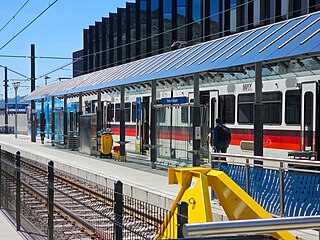The Pacific Maritime Association (PMA) is a non-profit organization based in San Francisco, California that represents employers of the shipping industry on the Pacific coast.

Portland International Airport is a joint civil–military airport and the largest airport in the U.S. state of Oregon, accounting for 90% of the state's passenger air travel and more than 95% of its air cargo. It is within Portland's city limits just south of the Columbia River in Multnomah County, 6 miles by air and 12 mi (19 km) by highway northeast of downtown Portland. Portland International Airport is often referred to by its IATA airport code, PDX. The airport covers 3,000 acres of land.

Powell's Books is a chain of bookstores in Portland, Oregon, and its surrounding metropolitan area. Powell's headquarters, dubbed Powell's City of Books, claims to be the largest independent new and used bookstore in the world. Powell's City of Books is located in the Pearl District on the edge of downtown and occupies a full city block between NW 10th and 11th Avenues and between W. Burnside and NW Couch Streets. It contains over 68,000 square feet, about 1.6 acres of retail floor space.

Hapag-Lloyd AG is a German international shipping and container transportation company, the 4th biggest in the world. It was formed in 1970 through a merger of Hamburg-American Line (HAPAG) and Norddeutscher Lloyd.

A dockworker is a waterfront manual laborer who loads and unloads ships.

The MAX Red Line is a light rail line serving the Portland metropolitan area in the U.S. state of Oregon. Operated by TriMet as part of the MAX Light Rail system, it is an airport rail link connecting Hillsboro, Beaverton, Portland City Center, and Northeast Portland to Portland International Airport. The Red Line serves 37 stations; it interlines with the Blue Line and partially with the Green Line from Hillsboro Airport/Fairgrounds station to Gateway/Northeast 99th Avenue Transit Center and then branches off to Portland Airport station. Service runs for 22 hours per day with headways of up to 15 minutes. The Red Line carried an average 10,310 passengers per weekday in September 2021, the second-busiest after the Blue Line.

Portland Airport is a light rail station in Portland, Oregon, United States, served by TriMet as part of the MAX Light Rail system. Situated at Portland International Airport, it is the eastern terminus of the Red Line, which connects the airport, downtown Portland, and Beaverton. The station is located at the ground floor of the airport's main passenger terminal near the southern end of the arrivals hall and baggage claim area.

Troutdale Airport, also known as Troutdale-Portland Airport, is a corporate, general aviation, and flight-training airport serving the city of Troutdale, in Multnomah County, Oregon, United States. It is one of three airports in the Portland metropolitan area owned and operated by the Port of Portland. Troutdale Airport was established in 1920 as a private airfield, then purchased by the Port of Portland in 1942. It serves as a reliever airport for nearby Portland International Airport (PDX).

Hillsboro Airport, also known as Portland–Hillsboro Airport, is a corporate, general aviation and flight-training airport serving the city of Hillsboro, in Washington County, Oregon, United States. It is one of three airports in the Portland, Oregon, metropolitan area owned and operated by the Port of Portland. Established in 1928, it is Oregon's second busiest airport at over 200,000 operations annually. HIO covers 900 acres and has three runways.
International Container Terminal Services, Inc. (ICTSI) is a global port management company headquartered in Manila, Philippines. Established in 1987, ICTSI is the Philippines' largest multinational and transnational company, having established operations in both developed and emerging market economies in Asia Pacific, the Americas, and Europe, the Middle East and Africa. The company is ranked the eighth largest container terminal operator, according to TEU equity volume.

The British Columbia Maritime Employers Association is an association representing the interests of member companies in industrial relations on Vancouver's and other British Columbian seaports.

HMM Company Limited, formerly known as Hyundai Merchant Marine, is a South Korean container transportation and shipping company.

The Swan Island Municipal Airport was a joint civil-military airport that was operational on Swan Island in Portland, Oregon. Though it officially opened in 1927, the United States Postal Service had been using the airfield for a year. After the Portland–Columbia Super Airport was completed in the late 1930s, Swan Island Municipal Airport had little use since its runways were too small for newer aircraft and the low altitude made takeoffs and landings difficult. The airport was operational for nearly two decades, but due in part to the advances in aviation, it became obsolete soon after its construction. During World War II, a Kaiser shipyard was located at Swan Island. The shipbuilding facilities were acquired by the Port of Portland after the war.

The Port of Manila refers to the collective facilities and terminals that process maritime trade function in harbors in Metro Manila. Located in the Port Area and Tondo districts of Manila, facing Manila Bay, it is the largest and the premier international shipping gateway to the country. The Philippine Ports Authority, a government-owned corporation, manages the Port of Manila and most of the public ports in the country. It is composed of 3 major facilities, namely Manila North Harbor, Manila South Harbor, and the Manila International Container Terminal.

The Port of Vancouver is the largest port in Canada and the fourth largest in North America by tonnes of cargo, facilitating trade between Canada and more than 170 world economies. The port is managed by the Vancouver Fraser Port Authority, which was created in 2008 as an amalgamation of the former Port of Vancouver, the North Fraser Port Authority, and the Fraser River Port Authority. It is the principal authority for shipping and port-related land and sea use in the Metro Vancouver region.

The Port of Iloilo is a seaport located in Iloilo City, Philippines. It serves the city, province of Iloilo, and the entire island of Panay in the Western Visayas region of the Philippines. It is located in the districts of Iloilo City Proper and Lapuz, on the southeastern coast of Panay, in Iloilo Strait, and one of the country’s safest and most natural harbors. The Port of Iloilo is managed by the Philippine Ports Authority, a government-owned corporation, and consists of major facilities: the Iloilo River Wharf, Iloilo Domestic Port, and the Visayas Container Terminal.

Francis J. Murnane (1914–1968) was a longshore worker from Portland, Oregon, United States who was called "the cultural and historical conscience of Portland" after playing a key or solitary role in preserving several historical monuments in the city. He was the president of his union, International Longshore and Warehouse Union (ILWU) Local 8, and died of a heart attack while presiding over a meeting. A memorial wharf dedicated to Murnane, located on the Willamette River at Tom McCall Waterfront Park, is slated for demolition in 2009. An effort to restore the Murnane memorial is underway.
Jadranska vrata is a Croatian port operating company which operates port facilities at the largest Croatian Port of Rijeka. Jadranska vrata d.d. company was founded as a Luka Rijeka d.d. subsidiary, and tasked with operating the container cargo terminal located in the Brajdica district of Rijeka. As of August 2011, the International Container Terminal Services Inc. (ICTSI) acquired 51% share in the company becoming a strategic partner, and the company is since also prominent under its English name—Adriatic Gate Container Terminal. Jadranska vrata d.d. has acquired a separate concession to operate the container terminal in the Port of Rijeka until 2041.

The International Longshore and Warehouse Union (ILWU) is a labor union which primarily represents dock workers on the West Coast of the United States, Hawaii, and in British Columbia, Canada; on the East Coast, the dominant union is the International Longshoremen's Association. The union was established in 1937 after the 1934 West Coast Waterfront Strike, a three-month-long strike that culminated in a four-day general strike in San Francisco, California, and the Bay Area. It disaffiliated from the AFL–CIO on August 30, 2013.

Portland International Airport (PDX) features an iconic carpet. Situated in Portland, Oregon, the carpet featured geometric shapes on a teal background, representing the intersection of the north and south runways seen by air traffic controllers from the airport's tower at night. The carpet's design proved popular, and is referenced and discussed in other media.






















